| CONSTANCE MEYER Articles |
|
They're hardly second string
The viola doesn't get much respect, as an entire genre of jokes proves. But try building a quartet without one. December 12, 2004 | by Constance Meyer | The Los Angeles Times Few violists are born. Most have the instrument thrust upon them. In fact, the viola -- the overlooked stepchild of the orchestra's string section -- is rarely studied as a first instrument at all. Until fairly recently, the road to mastering it invariably went through years of study on the violin, which is both smaller and pitched a fifth higher. Today, some novices do start on the viola. High school orchestra conductors have been known to entice kids to take it up by noting that "it looks good on your college application." Why? Because fewer young people study it, and they're always in demand for orchestras and chamber music groups. Yet despite usually being hidden behind the conductor, all but invisible to many concertgoers, violas and violists have long been the butt of jokes, of which there are untold thousands. And the instrument seems to inspire, if not outright derision, then indifference or just plain confusion.
Years ago, Neufeld suffered a neck injury in an automobile accident. "I was going to an orthopedist and undergoing physical therapy," he recalls. "I said, 'Doc, you know I play the viola for a living? Much as I'd hate to lose the work, do you think maybe it would be a good idea for me to take a rest?' " The physician's response, he says, was: "No, I don't think playing the viola should be a problem." "So I did my couple of weeks of playing and my neck was getting worse, and I told him, 'You know, holding that viola under my chin is really killing my neck.' " The response then? "Oh! Is that how you play the viola?" Neufeld admits that when he was younger, his own attitude toward the instrument was somewhat contemptuous, "programmed" by his violinist father, Erno, for 40 years the concertmaster at Universal Studios. Dan Neufeld was a violin major at UCLA when a professor in a chamber music class took a viola out of its case and said: "You will play the viola." "I was reluctant to even touch it!" he says. But "I have fairly long arms, and the violin always felt a little cramped. I played the first note of viola and said, 'My goodness, this is fun!' "
Now, Goldsmith says, she never misses an opportunity to educate the public. "I'll be standing in an elevator holding my viola case and people will say, 'What's that?' 'A viola. It's the alto member of the string family. It's larger than a violin. It has a much more beautiful, mellow tone,' and I keep right on talking till the elevator doors open." So is there a violist personality? According to Goldsmith, "Yes. You don't want to be a star. You're never going to play the Wieniawski Concerto. You do it because you love it, because you enjoy understanding the structure of the music, not just the melody. When you're in the center, for example, playing a Brahms symphony, the music swirling all around you, it's the most incredible aural experience -- thrilling."
Violists may also have less of a competitive streak than many musicians. Like Goldsmith, Roland Kato, principal violist with the Los Angeles Chamber Orchestra, began studying the violin in the L.A. school system. And in his junior high orchestra, he says, he won the seat of concertmaster. The trouble was, by doing so he dethroned its previous occupant. 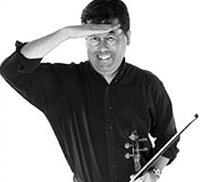
"She had a stage mom and was very upset, crying, blubbering, 'My mother's going to kill me because I lost the chair.' I didn't understand what she was talking about, because my parents -- second generation Japanese Americans, who were interned in Idaho and California during WW II, weren't pushy or manipulative. She challenged me a bit later for her seat. I said, 'Forget it, I don't care.' I just moved into the viola section." Kato then experienced a "seminal moment" that led him to make the move permanent: "I had put the violin on my bed and was getting things from the shelf above, and things fell on the violin. The thing that actually made the bridge go through the instrument was a Ouija board. I took it as a definite sign." The physical challenge Traditionally larger than a violin, the viola does require extra capability. Says Dembow: "You have to be accommodating physically to play the instrument. If violin is not the most natural instrument in the world, viola is even more so." When he first tried playing it as a teenager, "it felt really miserable -- ungainly and uncomfortable."
In addition to her opera work, Pitelka does studio dates, is principal violist for the Los Angeles Master Chorale and the Long Beach Symphony, and is a member of the chamber group Xtet, now in its 20th year. But opera, she says, is "exceptionally strenuous. It hurts. It takes stamina. It's very hard. Playing Richard Strauss' 'Die Frau Ohne Schatten' is like playing Mahler's Fifth, taking an intermission, playing Mahler's Fifth, taking an intermission and doing it a third time. The sheer weight of a large viola can really be problematic and lead to overuse injury. Some people play on a small viola to try to protect themselves. But in truth, bigger violas sound better, so you want to find some way to get the volume and the string length without having too much weight." As Goldsmith puts it, no matter your height, playing the viola is an "athletic event." And as Pitelka suggests, violists, in particular, are prey to repetitive stress syndrome, which can cause pain and inflammation in their wrists, elbows and shoulders. To understand why, Goldsmith says, "all you have to do is look at the viola part in a score. So often we are called upon to play a rhythmic figure over and over to accompany a melody." Another part of the problem, Goldsmith explains, is "there is no standardization in the size of the viola. They basically come in small, medium and large. You have to find an instrument that fits your body. When I started out, there were very few women violists, and most of the men played large violas. I remember at an audition the conductor said to me, 'That's a small viola you're playing,' and I said, 'Yes,' and he said, 'I wouldn't let anyone in my section play a viola so small.' " Times have changed, though. Most musicians hesitate to acknowledge any injury, lest it affect their job prospects. But increasingly, there's more experimentation with viola size and sound. "I think there's been a move now for people to just get comfortable," Goldsmith says -- meaning that today's violists are not ashamed to play smaller instruments.
Some rays of hope, paths to glory There are a few precious moments in the orchestral repertoire where the viola is the star, when the violin is absent and a violist is concertmaster. They include the sixth of Bach's Brandenburg Concertos and Brahms' Serenade No. 2 in A, Opus 16. And the solo viola repertoire is much slimmer than that for violin or cello. Mozart wrote two viola quintets and the Sinfonia Concertante, a concerto for violin and viola. William Walton wrote a viola concerto, as did Bela Bartok. Paul Hindemith, the German-born composer and violist who was on the faculty at Yale for many years, wrote perhaps the most for viola in the 20th century, including a concerto -- so he could have pieces to perform.
Pitelka agrees with a close violist friend whose goal was to have her instrument sound like Nat King Cole. "That has really stuck with me." Meanwhile ... What's the difference between a violist and Bin Laden hiding in an Afghan cave? Everyone's looking for Bin Laden. There doesn't seem to be any justice: Viola jokes just keep coming, even managing to stay au courant. But dedicated violists count on their devotion to their craft to protect them. Says Kato: "Playing well is the best revenge." | |
|
Copyright 2004 Constance Meyer. All rights reserved |
|
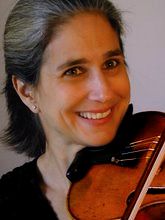
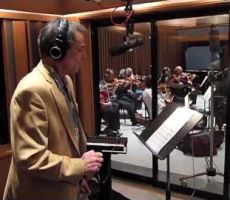 Dan Neufeld, a busy L.A. studio violist, says: "Very often, you'll be introduced to somebody and you say, 'I play the viola,' and the next time they see you they'll say, 'How's the cello?' The mind says it's a stringed instrument and it's not the violin." Another frequent comment, he says, is "Gee, I go to the symphony all the time, and I've never seen a viola."
Dan Neufeld, a busy L.A. studio violist, says: "Very often, you'll be introduced to somebody and you say, 'I play the viola,' and the next time they see you they'll say, 'How's the cello?' The mind says it's a stringed instrument and it's not the violin." Another frequent comment, he says, is "Gee, I go to the symphony all the time, and I've never seen a viola."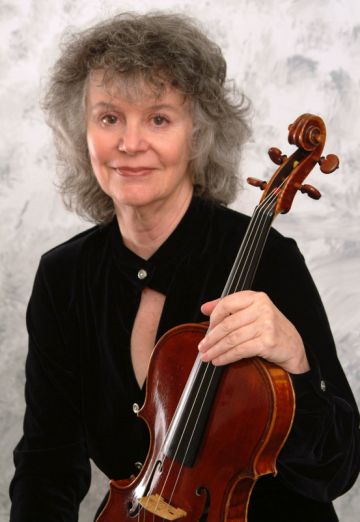 Pam Goldsmith, an adjunct professor of viola at USC and a past recipient of the "most valuable player" award from the National Academy of Recording Arts & Sciences, tells a similar story. She was "just an ordinary kid in the third grade"
when she began violin lessons in the Los Angeles public school system. At about age 15, while fraternizing with a violist during an orchestra break, she startled herself by saying, " 'Hey, let me try your viola.' I just played a few notes,
and the heavens opened up and lightning struck. I knew this was my voice."
Pam Goldsmith, an adjunct professor of viola at USC and a past recipient of the "most valuable player" award from the National Academy of Recording Arts & Sciences, tells a similar story. She was "just an ordinary kid in the third grade"
when she began violin lessons in the Los Angeles public school system. At about age 15, while fraternizing with a violist during an orchestra break, she startled herself by saying, " 'Hey, let me try your viola.' I just played a few notes,
and the heavens opened up and lightning struck. I knew this was my voice."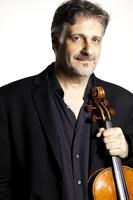 Until he was in his mid-30s,
Brian Dembow was a successful concert violinist. But he had long played viola as well, and he finally decided to take it up full time. Now he's the violist with the Angeles Quartet and a first-call freelancer. "I have
to say my personality is much better suited to playing the viola," he says. "I don't need to be in the limelight. I'm happy being in a supportive role. I find it less stressful not being part of the energy that surrounds violinists and that they help
create themselves."
Until he was in his mid-30s,
Brian Dembow was a successful concert violinist. But he had long played viola as well, and he finally decided to take it up full time. Now he's the violist with the Angeles Quartet and a first-call freelancer. "I have
to say my personality is much better suited to playing the viola," he says. "I don't need to be in the limelight. I'm happy being in a supportive role. I find it less stressful not being part of the energy that surrounds violinists and that they help
create themselves."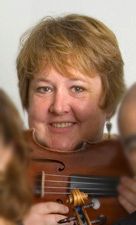 At 6-foot-2,
Kazi Pitelka certainly has the physical equipment for the task. The principal violist for Los Angeles Opera since 1991, she looks back fondly to 1974, when she went to audition for Lillian Fuchs, the 4-foot-9 grande dame violist and
viola teacher in New York. Fuchs "whipped open the door, her eyes going all the way from my feet up to my head. 'Dearie, you were born to play the viola!' When I played the viola, she could walk under it. That's how tall I am and how small she was."
At 6-foot-2,
Kazi Pitelka certainly has the physical equipment for the task. The principal violist for Los Angeles Opera since 1991, she looks back fondly to 1974, when she went to audition for Lillian Fuchs, the 4-foot-9 grande dame violist and
viola teacher in New York. Fuchs "whipped open the door, her eyes going all the way from my feet up to my head. 'Dearie, you were born to play the viola!' When I played the viola, she could walk under it. That's how tall I am and how small she was."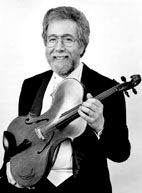 There are even some players who are courageous enough, or desperate enough, to buck tradition and use one of the ergonomically designed Pellegrina violas made by Oregonian David Rivinus. Though distasteful to purists because of their stretched
yet shrunken appearance, these instruments have enabled certain violists, such as
Don Ehrlich of the San Francisco Symphony, to play without misery. Before he made the switch, Ehrlich says, he was in severe pain from tendinitis at two places in his
left elbow and feared "being badly injured."
There are even some players who are courageous enough, or desperate enough, to buck tradition and use one of the ergonomically designed Pellegrina violas made by Oregonian David Rivinus. Though distasteful to purists because of their stretched
yet shrunken appearance, these instruments have enabled certain violists, such as
Don Ehrlich of the San Francisco Symphony, to play without misery. Before he made the switch, Ehrlich says, he was in severe pain from tendinitis at two places in his
left elbow and feared "being badly injured." In movies and TV, by contrast, the viola is used frequently to underscore sad or poignant moments. It's been said that if a baby dies, that's a viola solo. Goldsmith recalls the violinless score for the 1981 Richard Dreyfuss
film "Whose Life Is It Anyway?" -- "about a guy who's paralyzed and dying. He wants to kill himself." On another score, she says, she "played a viola solo when the baby dinosaur died." She had a big solo for a love scene in 1979's
"Old Boyfriends," which prompted her to thank composer David Shire "for thinking of the viola in this way, instead of in terms of death." But she was disheartened to learn: "Well, you see, when she's making love to this guy, she's really
thinking about his dead brother, the one she really loved."
In movies and TV, by contrast, the viola is used frequently to underscore sad or poignant moments. It's been said that if a baby dies, that's a viola solo. Goldsmith recalls the violinless score for the 1981 Richard Dreyfuss
film "Whose Life Is It Anyway?" -- "about a guy who's paralyzed and dying. He wants to kill himself." On another score, she says, she "played a viola solo when the baby dinosaur died." She had a big solo for a love scene in 1979's
"Old Boyfriends," which prompted her to thank composer David Shire "for thinking of the viola in this way, instead of in terms of death." But she was disheartened to learn: "Well, you see, when she's making love to this guy, she's really
thinking about his dead brother, the one she really loved."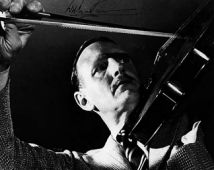 As for role models, Neufeld speaks for many violists when he lauds the late
William Primrose, a Scot who was on the faculty at USC during the '60s and had a trio there with violinist Jascha Heifetz and cellist Gregor Piatigorsky. "When William
Primrose came to the forefront," he says, "we had as our hero one of the world's outstanding instrumentalists." Dembow adds: "Primrose was in some ways even greater than Heifetz, because he sounded the way he did on the viola, which is much
more difficult to do."
As for role models, Neufeld speaks for many violists when he lauds the late
William Primrose, a Scot who was on the faculty at USC during the '60s and had a trio there with violinist Jascha Heifetz and cellist Gregor Piatigorsky. "When William
Primrose came to the forefront," he says, "we had as our hero one of the world's outstanding instrumentalists." Dembow adds: "Primrose was in some ways even greater than Heifetz, because he sounded the way he did on the viola, which is much
more difficult to do."